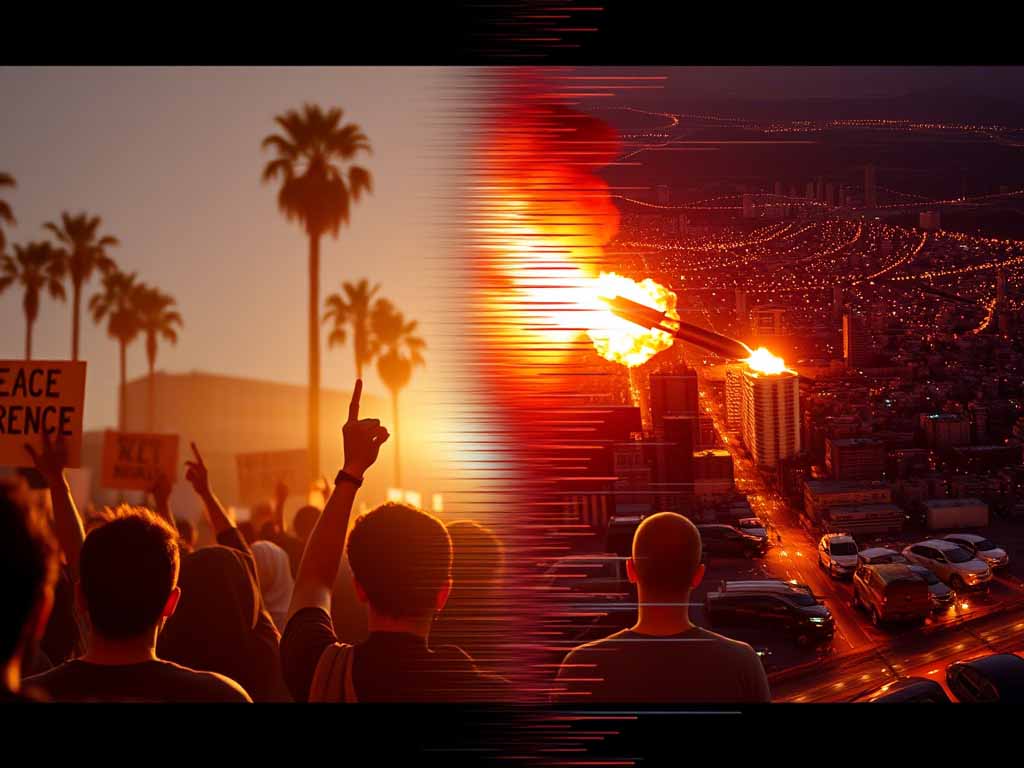We’ve always known misinformation could spread fast — but with artificial intelligence, it’s spreading faster, louder, and more convincingly than ever before.
Just days ago, social media platforms exploded with chaos during the peaceful protests in Los Angeles. Fake images and AI-generated videos transformed real events into online drama. But that wasn’t the end of it. The same tools used to mislead people in LA quickly found their way into an even more dangerous situation: the rising conflict between Israel and Iran.
From city streets to international politics, AI-generated lies are going global, and they’re changing how we experience reality.
When War Meets Deepfakes
In the heat of the escalating Israel-Iran conflict, people turned to social media to stay updated — and that’s when the trouble started. Within hours of the first missile strike headlines, platforms like X (formerly Twitter), TikTok, and Telegram were flooded with content that looked shockingly real… but wasn’t.
- Videos of airstrikes with perfect camera angles — but digitally created.
- Photos of destroyed buildings — generated by AI tools, not captured by journalists.
- Fake breaking news reports with voice-cloned anchors reporting attacks that never happened.
Some were made to spread fear. Others to trigger panic. And many were shared by people who genuinely thought they were real.
The Power of a Good Lie
The scariest part? Most of these fakes didn’t look fake.
AI tools like Midjourney, DALL·E, and Sora can now generate incredibly realistic visuals. Add in tools like ElevenLabs for voice cloning or ChatGPT for writing scripts, and you’ve got a powerful recipe for believable deception.
In the Israel-Iran case, deepfake videos of world leaders surfaced, supposedly showing them declaring war, calling for peace, or confirming casualties — none of it true. But in a region where every word matters, even one false statement can spark massive consequences.
And just like that, AI becomes a digital matchstick in a very real fire.
Misinformation in Action: By the Numbers
Let’s look at how AI-powered fakes spread during recent major events:
AI Misinformation Spread Across Events (Fake Images + AI Videos)
As shown above, the Israel-Iran conflict and Ukraine war topped the chart with the most AI-generated fakes — both images and videos. And it’s not slowing down. In fact, experts predict these numbers will double in the next 12 months.
The message is clear: AI lies don’t just go viral — they go global.
The Human Cost of Digital Lies
Disinformation during wartime isn’t just a tech problem — it’s a human one. Here’s how it affects real people:
- Civilians panic after seeing fake videos of attacks in their neighborhoods.
- Families worry because they see voice-cloned leaders announcing new bombings.
- Governments react to threats that never actually happened.
In short: AI doesn’t just confuse people — it changes behavior, sparks fear, and can even drive countries closer to war.
From LA to Tehran: Misinformation Timeline
Let’s compare how AI-driven fakes unfolded during the LA protests and the early days of the Israel-Iran escalation.
Timeline of Disinformation Spread During LA Protests
In LA, fake content surged on Day 2 and completely overshadowed real news by Day 5. The same pattern was seen during the Israel-Iran tensions: a burst of AI content in the first 48 hours, when people were most desperate for updates.
Why is this pattern important? Because it shows exactly when bad actors strike: when the world is watching, and people are most vulnerable to believing what they see.
Real People, Real Reactions
Some users shared how the fake content affected them:
“I saw a video of Tel Aviv getting bombed and started crying… Later I found out it was made with AI.”
— @news_watcher_23
“I reposted what I thought was a government announcement. Turns out it was a voice-cloned fake. Now I don’t trust anything.”
— anonymous TikTok user
These are not isolated cases. They’re part of a growing trend — digital trauma from AI-generated disinformation.
The Platforms Are Playing Catch-Up
Social media companies are trying to fight back, but let’s be honest — they’re losing the race.
While some platforms like YouTube and Instagram have begun tagging AI content or banning certain deepfake tools, many others still let false content go viral. The problem? Most platforms rely on users to report fakes after the damage is done.
And by then, it’s too late. Most viewers won’t see the correction — they’ll remember the lie.
Can AI Solve the AI Problem?
Ironically, yes. AI tools are also being used to detect and flag AI-generated content. Here’s how:
- Deepfake detection software trained to recognize manipulated pixels or audio patterns.
- Bot activity monitors that track mass posting behavior.
- Fact-checking AI that scans viral posts and compares them with trusted sources in real-time.
But this is a digital arms race. As detection tools improve, so do the fakers.
What Can Be Done?
Here’s what governments, platforms, and we — the public — can do to reduce AI-powered chaos:
Governments:
- Pass regulations requiring clear labeling of AI-generated content
- Enforce strict penalties for spreading war-related deepfakes
Social Platforms:
- Build real-time misinformation alert systems
- Offer visible warnings on viral AI posts
You and Me:
- Don’t share anything unless it’s verified
- Use reverse image search or AI detectors like Hive or InVID
- Think critically — especially during conflict
Remember: if something shocks you emotionally or seems “too perfect,” it’s worth checking before clicking “share.”
Final Thought: Trust Is Now a Choice
We’re entering a new phase of human history — one where truth is editable, and reality is up for grabs. AI doesn’t just generate fake content. It changes minds, shapes headlines, and shifts how people think about the world.
The LA protest disinformation was bad. The Israel-Iran fakes were worse. Next time? It could be your city. Your country. Your phone.
In a world full of AI-generated noise, being informed is more than smart — it’s survival.
Here are articles to help you stay sharp in this AI-powered world:



